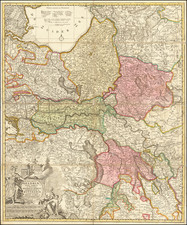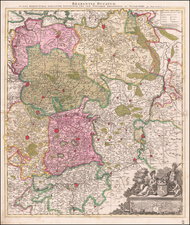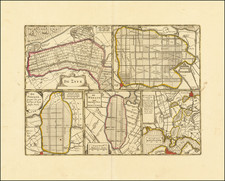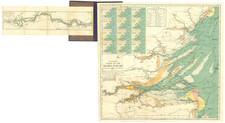This 1574 copperplate map by Girolamo Ruscelli is focused on the Low Countries, encompassing present-day Netherlands, Belgium, and Luxembourg, while also extending into southeast England. As one of the earliest modern maps of the region, it stands as a significant piece in the evolution of cartography.
The 16th century was a vibrant period in the Low Countries, marked by the turmoil of the Eighty Years' War and profound shifts in trade, science, and arts. With the Low Countries at the crossroads of Europe, their geographical mapping was a matter of keen interest. Ruscelli's map, in this context, captures the detailed topography and political boundaries of the region during a transformative historical epoch, bridging the understanding between the medieval and modern era cartography.
Ruscelli's atlas was an expanded and improved iteration of Gastaldi's Geografia (1548), acknowledged as one of the most comprehensive atlases of the period. The importance of Ruscelli and Gastaldi's work lies in their pioneering use of copperplate engraving. This marked a significant departure from the earlier practice of woodcut printing and represented a significant advancement in cartographic precision and detail. The harder copper allowed for more intricate detailing, enabling Ruscelli to render the varied topography of the Low Countries with remarkable accuracy.
The map is notable for its precise rendering of cities, rivers, islands, and other geographic features, with meticulous attention paid to the positioning of these elements in relation to each other. The plethora of toponyms transcribed, ranging from "LONDRA" and "ISOLE DI ZILANDA" to smaller locations like "Fofdich" and "Texel", attest to Ruscelli's commitment to accuracy. The breadth of Ruscelli's work is a testament to the geographic and ethnographic knowledge of the period, with the Geografia constituting a significant contribution to the geographical understanding of the 16th century.
Girolamo Ruscelli (1500-1566) was a cartographer, humanist, and scholar from Tuscany. Ruscelli was a prominent writer and editor in his time, writing about a wide variety of topics including the works of Giovanni Boccaccio and Francesco Petrarch, Italian language, Italian poetry, medicine, alchemy, and militia. One of his most notable works was a translation of Ptolemy’s Geographia which was published posthumously.
There is limited information available about Ruscelli’s life. He was born in the Tuscan city of Viterbo to a family of modest means. He was educated at the University of Padua and moved between Rome and Naples until 1548, when he moved to Naples to work in a publishing house as a writer and proofreader. He remained in the city until his death in 1566.










![[Entrance to the Thames] Carte Des Entrees de la Tamise](https://storage.googleapis.com/raremaps/img/small/77484.jpg)

![[ Holy Roman Empire ] Germania del Gastaldo](https://storage.googleapis.com/raremaps/img/small/73754.jpg)

